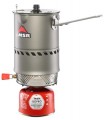Power
The rated power of the burner is the amount of heat generated by it during operation. For models with power control, the value is indicated at the maximum mode.
The nuances of choosing this parameter depend on the type of device. So, the general rule for burners and stoves (see "Type") states that at least 1 kW of power is needed to efficiently heat 1 liter of liquid. And the volumes that you have to deal with depend on the number of tourists and the expected conditions: in a warm climate, 600-700 mL per person is enough for 1 cooking, in a cool one — 1 liter, and it is better to clarify recommendations for different types of extreme tourism in special sources. Thus, the minimum indicator for burners is actually
1 kW, for stoves —
1.5 kW, and the most powerful ones can provide
3 kW or more. Note that more powerful burner models have the appropriate dimensions and weight, and you can heat a large amount of food several times; so for long hikes with luggage carried on you, a relatively low-powered device may be more suitable.
In the case of heaters, it can be assumed that a power of 1 – 1.5 kW is enough for 5 – 7 m2 of area — this is quite enough to heat a tent or tent, higher power is rarely required in fact. And for lamps, the main indicator of efficiency is not power, but luminous flux (see below).
Continuous operation time
The time that the burner is able to work without changing the cylinder or refilling the tank. Usually, the characteristics indicate the operating time at maximum power (see above); at lower power, the actual operating time may be longer than stated. However, it is best to evaluate and compare different models by directly claimed battery life.
Another important nuance is that battery life directly depends on the volume of the fuel tank — and many modern burners are designed for interchangeable cylinders produced in different volumes. Therefore, the characteristics may indicate for which cylinder model the continuous operation time is given (and for
multi -fuel models, the type of fuel should also be specified). If there are no such data, the tank capacity required for a certain time can be calculated from fuel consumption: for example, gas consumption of 180 g / h and battery life of 120 min (2 h) mean that the data are given for a cylinder of at least 360 g (400 mL) gas. With other volumes, the time of continuous operation will differ accordingly.
Boiling time for 1 L of water
Approximate time required to boil 1 liter of cold water on the burner. Of course, in fact, the boiling time may differ from the claimed one, since it is affected by the shape and material of the dishes, ambient temperature, etc.; however, this parameter quite clearly characterizes the overall efficiency of the device, it is quite possible to compare different models with each other. At the same time, it should be taken into account that when working with other volumes, the time may not change in direct proportion: for example, if 1 liter requires 300 s, then 2 liters may require not 600 s, but more, but 0.5 L — not 150 s, but less.
Piezo ignition
Built-in flame ignition system based on a
piezoelectric element. Such an element does not require batteries: it generates electricity by pressing the ignition button, and ignition is carried out using an electric spark. This function allows you to do without matches, lighters and other external sources of fire; however, if desired, the flame can be ignited with their help, without the use of piezo ignition.
Replaceable balloons
Models of cylinders for the use of which the burner is structurally designed. Usually, the cylinders specified in the specifications are guaranteed to be compatible with the burner in the standard configuration — up to the point that for models equipped with adapters for different types of fasteners (for example, from thread to collet, see "Cylinder Mount"), this paragraph often indicates both regular and "non-native" cylinders.
Knowing the names of the cylinders, you can easily find fuel for the burner in specialized stores.
Weight
The total weight of the device. Usually, the specifications indicate "dry" weight — excluding fuel.
Lightness is important on long hikes where you have to carry your gear; on the other hand, ceteris paribus, less weight means either low strength and reliability, or greater cost. The lightest classic type burners and lamps (see "Type") weigh
up to 200 g, in the working position, most of the mass of such a device falls on fuel. However, there are also more massive models. For plates, in turn, lightness is not critical, and most of these models are quite heavy —
1 kg or more. In heaters, the weight can be different — from 60 – 70 g in pocket hand warmers to 1.5 kg (or even more) in powerful outdoor appliances.

